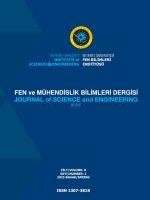ANKASTRE BUZDOLAPLARI İÇİN TASARLANAN SERPANTİN YOĞUŞTURUCULARIN ISI TRANSFERİ ÜZERİNE DENEYSEL TESTLERİ
Bir buhar sıkıştırmalı soğutma çevrimi, bir kompresör, bir yoğuşturucu, bir genleşme valfi ve bir buharlaştırıcıdan oluşan kapalı bir çevrimdir. Soğutma sisteminin performansı önemli ölçüde yoğuşturucuya bağlıdır. Bu çalışmanın amacı, ankastre buzdolaplarının kompakt yoğuşturucusunun üzerinde ısı transferi testleri yapmak ve test sonuçlarına göre iyileştirme önerileri sunmaktır. Giriş bölümünde ankastre buzdolaplarında kullanılan yoğuşturucu tipi ve ısı transferini etkileyen parametreler hakkında bilgi verilmiştir. Malzeme ve yöntemler bölümünde seçilen serpantin tipi yoğuşturucu ve monte edildiği yer üzerindeki kısıtlamalar anlatılmaktadır. Kullanılacak deney düzeneği hakkında açıklayıcı bilgiler de bu bölümde bulunabilir. Sonuçlar bölümünde ise serpantin kondenser üzerinde yapılan deneylerin sonuçları verilmiştir. Tartışma bölümündeki test sonuçları incelenmiş ve yoğuşturucunun buzdolabındaki performansının artırılmasına yönelik önerilerde bulunulmuştur. Sonuçlar, yoğuşturucu performansını belirleyen önemli bir parametre olan ısı transfer kapasitesinin ve aşağı çekme sıcaklığının yoğuşturucu yüzeyi ile doğrudan ilişkili olduğunu göstermektedir. Ayrıca, yoğuşturucu ısıl kapasitesi yeterli olsa bile, aşağı çekme sıcaklığının da dikkate alınması gerektiği sonucuna varılabilir. Serpantin yoğuşturucunun ısıl kapasitesi gereksinimleri karşılamasına rağmen, aşağğı çekme sıcaklığının istenilen değerlerde olmadığı görülmektedir.
Anahtar Kelimeler:
serpantin yoğuşturucu, optimizasyon, buzdolapları, ısı transferi, soğutma sistemi
EXPERIMENTAL TESTS ON HEAT TRANSFER IN COIL CONDENSERS DESIGNED FOR BUILT-IN REFRIGERATORS
As well known, a vapor compression refrigeration cycle is a closed cycle consisting of a compressor, a condenser, an expansion valve and an evaporator. The performance of the cooling system is significantly dependent on the condenser. The aim of this study is to conduct heat transfer tests on the compact condensers of built-in refrigerators and to propose improvement suggestions according to the test results. In the introduction section, information is given about the type of condenser used in built-in refrigerators and the parameters affecting the heat transfer. In the material and methods section, the selected coil type condenser and the constraints on the component where it is mounted are explained. Explanatory information about the experimental setup to be used can also be found in this section. In the results section, the results of the experiments on the coil condenser are given. The test results in the discussion section were examined and suggestions were made to increase the performance of the condenser on the refrigerator. The results show that the heat transfer capacity, which is an important parameter determining the condenser performance, and the pulldown temperature are directly related to the condenser surface. It can also be concluded that even if the condenser thermal capacity is sufficient, the pulldown temperature should also be taken into account. Although the thermal capacity of the coil condenser meets the requirements, it is observed that the pulldown temperature is not at the desired values.
Keywords:
coil condenser optimization, refrigerators, R134a, heat transfer, cooling system,
___
- [1] Cengel, Y.A, Ghajar, A.J. (2020). Heat and mass transfer: Fundamentals&Applications (Sixth edition). Singapore: McGrawHill Education
- [2] He W., Dai Y., Wang J., Li M., Ma Q. (2012). Performance prediction of an Air-cooled steam condenser Using UDF method, Applied Thermal Engineering, In Press.
- [3] Tezcan, A. (2018). Modelling and optimization of double cycled condenser where is used on built in refrigerators, Trakya University doctorate thesis.
- [4] Heisen, K. (1998). Coil type condenser for refrigerator, Daewoo Eleoctronics Co Ltd, Application number: JP2000018849A.
- [5] Arslankiray, Z. (2008). Cooling device with coil condenser, Bsh Bosch Sıemens Hausgeraete, Application number: TR200808917A.
- [6] Lee T-S., Wu W-C., C Y-K., Wang S-K. (2010). An improvement of airflow and heat transfer performance of multi-coil condensers by different coil configurations, International Journal of Refrigeration, Volume 33, Issue 7.
- [7] Elsayed A., Al-dadah RK., Mahmoud S. & Rezk A. (2012). Experimental and theoretical investigation of small-scale cooling system equipped with helically coiled evaporator and condenser. Proceedings of the Institution of Mechanical Engineers Part C-Journal of Mechanical Engineering Science, 226(3), 724-737.
- [8] Hofmanas . &9Paukstaitis L. (2012). Numerical heat transfer investigation of wire-and-tube condenser. Proceedings of 17th International Conference, 18(2), 82-87.
- [9] Wang H.S. & Honda H. (2001). Effects of tube diameter and tube side fin geometry on the heat transfer performance of air-cooled condensers. Journal of Enhanced Heat Transfer, 8(5), 315-327.
- ISSN: 1307-3818
- Başlangıç: 2007
- Yayıncı: Beykent Üniversitesi
Sayıdaki Diğer Makaleler
MÜHENDİSLİK ÖĞRENCİLERİNDE COVID-19 PANDEMİSİNİN ERGONOMİK KOŞULLAR ÜZERİNE ETKİSİ
Sabahattin BERKMEN, Yunus Can ÖZALP
“TÜRKİYE’DE İLK VE TEK, ‘VİRÜS-FREE KAMPÜS’: DOĞUŞ ÜNİVERSİTESİ ATAŞEHİR DUDULLU YERLEŞKESİ”
Alper TEZCAN, Ahmet CİHAN, Kamil KAHVECİ
Ecem ŞEN, Melih Soner ÇELİKTAŞ
COVID-19 SÜRECİNDE KALABALIK ve KİŞİSEL ALAN ALGISI: MARKET ALIŞVERİŞİ ÖRNEĞİ
